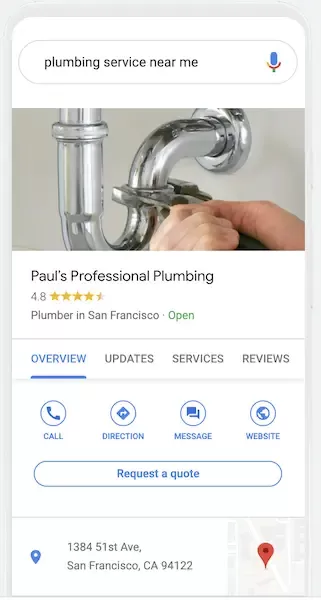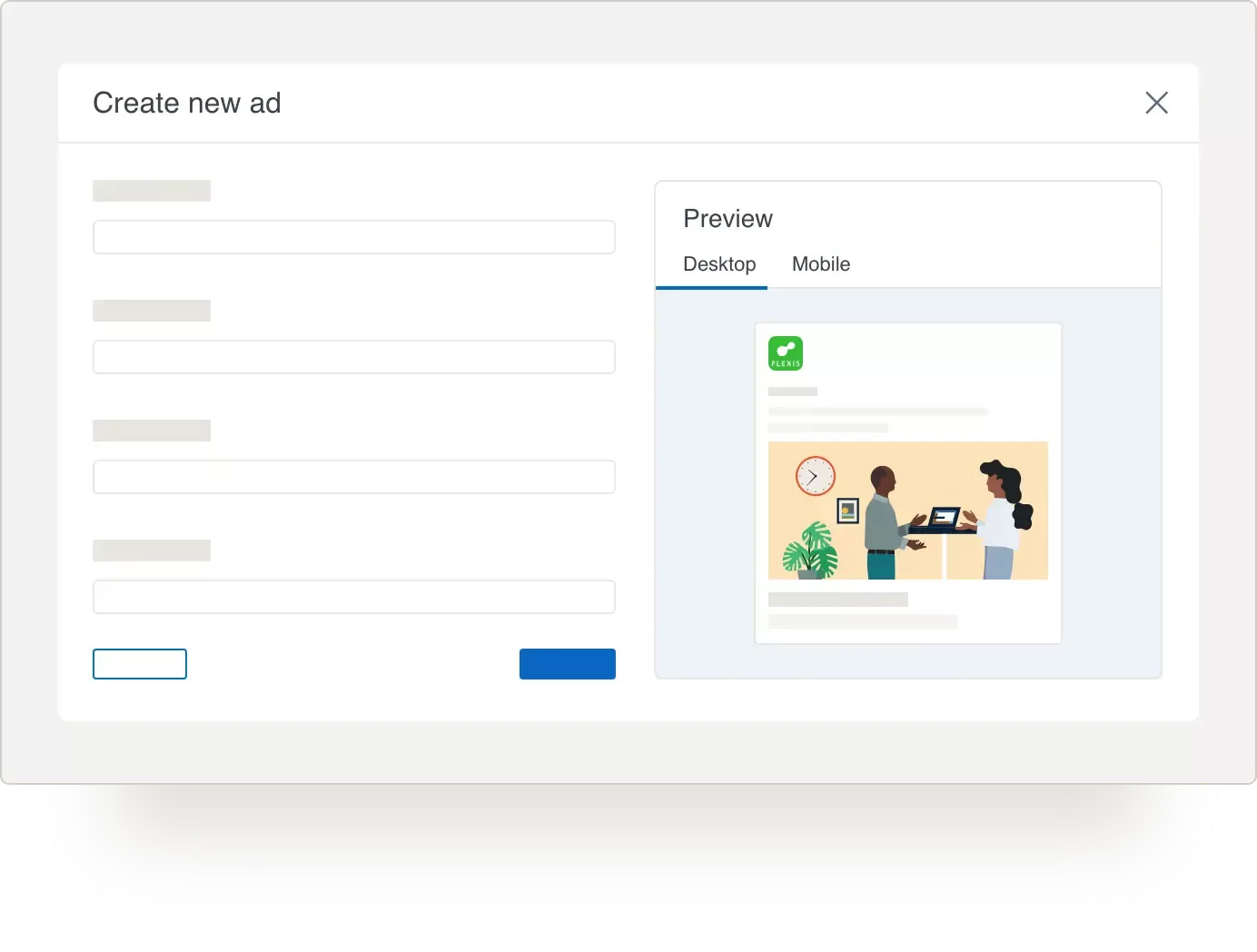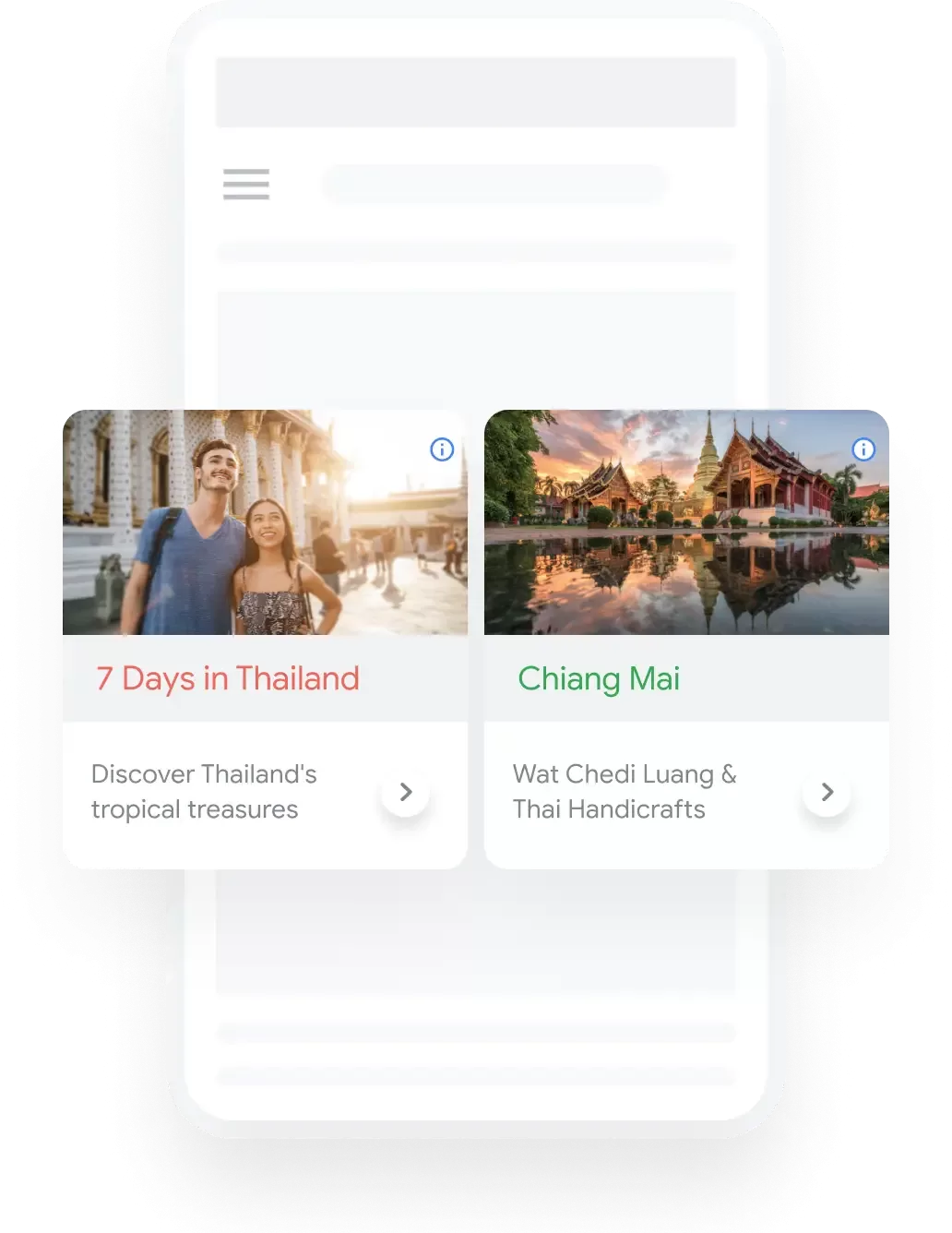If you’re a B2B business that wants to present a clear value proposition that helps you stand out from competitors, you should be including digital paid media marketing, and more specifically paid media advertising, in your strategy. But with so many ways to approach it and other channels competing for your marketing budget, you need to know what your options are and which paid media strategies are the best for your business goals.
So what are the types of paid media advertising channels your business should be considering? To stay competitive, your marketing plan should include search advertising, social media advertising, display advertising, landing page optimization, and programmatic marketing. The following provides a summary of each advertising channel as they relate to a B2B marketing program, along with the benefits that your business can expect from each.
Search Advertising
Paid search advertising, also known as pay-per-click or PPC, is a type of paid media advertising wherein companies pay search engines to place their ads higher on search engine results pages, like those of Google and Bing. Whether it’s increasing security concerns or finding audiences for complex products and services, paid search should be a part of your marketing tool kit for overcoming any number of challenges. Paid search advertising leverages enhanced visibility, targeted reach, increased website traffic, and data-driven insights to effectively position your business in front of your target audience, drive qualified traffic, and boost conversions. To be successful using Search ads, you also need to have a clear understanding of your target customers, which will help define your audiences.

Here are some of the benefits that your B2B marketing program can see when using Search advertising:
1. Enhanced visibility and targeted reach
By investing in paid search campaigns, your business can secure prominent ad placements on search engine results pages (SERPs) like Google and Bing while increasing your chance of appearing above organic search results. Paid search ads receive a significant share of clicks on SERPs, particularly for business-related searches for users that are looking for a specific product or service.
Be strategic by targeting relevant keywords and optimizing ad copy so your business can capture the attention of potential customers actively searching for the products or services you offer. This targeted approach helps increase brand visibility, drive qualified traffic to your website, and ultimately win market share from competitors.
2. Increased website traffic and conversions
When you strategically spend your time and marketing budget in well-optimized paid search campaigns, you can drive a steady stream of highly targeted traffic to your website, with a higher potential for immediate results.
If you’re able to develop a paid search strategy that places your ads at the top of search engine results, your business can attract users who are actively seeking goods and services that you specifically offer, resulting in higher click-through rates, increased website visits, and a high likelihood to convert. With compelling ad copy, relevant landing pages, and clear calls-to-action, your digital marketing can guide users through the conversion funnel, increasing the chances of lead generation, sales, or other desired actions.
3. Measurable and data-driven results
Paid search will give you detailed insights into the performance and overall value of your ads, so you can make data-driven decisions. By utilizing tracking pixels, conversion tracking, and analytics platforms like Google Analytics or Adobe Analytics, you can accurately track the performance of your paid search campaigns and optimize them for maximum ROI.
Keep an eye on key performance indicators (KPIs) such as click-through rate (CTR), conversion rate, and return on ad spend (ROAS), as these are the metrics that will help you evaluate the effectiveness of paid search campaigns. By continuously monitoring and analyzing campaign data, you can refine targeting, ad messaging, and bidding strategies, enabling your business to stay competitive and drive downstream KPIs like sales. Pair these front-end results with your back-end CRM data through closed loop reporting, and you will have a nearly comprehensive view of your marketing input and output!
Before you start, know where you stand
Use this Google Ads Account Audit guide to get a comprehensive assessment of your current paid media programs. You'll see what's working and what's not, so you can pull successful elements through into your new plan, and identify where you need to add new tactics and strategies. This valuable free guide covers it all.
Social Media Advertising
The advanced targeting options offered by social media advertising make it a valuable tool for both B2C and B2B businesses. For B2B in particular, it’s hard to beat the targeting options available to you through LinkedIn. There are few platforms better for building deeper relationships with existing customers, and there are ways to harness data-driven insights to help position your brand at the forefront and outperform your rivals. Social media platforms such as LinkedIn, Twitter, and Facebook provide unparalleled opportunities to reach engaged audiences with precision.

1. Highly targeted advertising for engaged audiences
One of the many ways your business can connect with relevant individuals is to target those who are already following competitor accounts. This strategic approach allows you to create compelling ads that showcase your business's unique values and advantages, enticing potential customers to choose you over your competitors.
Crafting strong calls to action and highlighting your brand's differentiators can help ads generate leads, increase brand awareness, and establish a strong foothold in the market. This granular targeting ensures that your ads are seen by the most relevant and engaged audiences, maximizing the effectiveness of your social media advertising campaigns.
2. Building deeper relationships with existing audiences
Social media platforms offer a unique opportunity to foster and strengthen relationships with your existing customers, leads, and prospects. Your social media followers are already connected to your brand, having either done business with you before or shown interest in your offerings. These individuals are more likely to choose your company over competitors, especially when your brand remains top-of-mind.
Consistently update your social media ad content and engage with your audience, and you can keep your brand messaging front and center, ensuring that when the time is right, customers turn to you for solutions.
3. Using analytics to inform insights
Social media advertising provides access to a wealth of data and analytics that can inform and optimize your B2B marketing strategies. Social media platforms offer robust tracking and measurement capabilities of your campaigns to help identify trends and refine your targeting and messaging. This approach, backed by data, allows you to stay agile, adapt quickly to market changes, and outperform competitors.
Prioritize data analysis and tracking to deliver measurable results that help other stakeholders within your business understand the benefits of your social media ads. Advertising on social platforms beyond LinkedIn isn’t always the first tactic that comes to mind for a B2B business, so it’s important that everyone understands their value.
Display Advertising
Display advertising, typically run through the Google Display Network (GDN), offers the ability to enhance brand building, increase impressions and clicks, provides targeted tracking, and it can be a big boost for digital marketers looking to win market share. If you’re on the fence about running it, consider that Display helps you to:
1. Improve brand building
Display advertising offers an excellent platform for brand building. Display ads help your business increase brand visibility, create awareness, and establish a positive brand image among your target audience. By leveraging eye-catching visuals and compelling messaging, you can effectively communicate your brand's value proposition and differentiate your business from competitors.
2. Increase impressions and clicks
Display ads are designed to capture users' attention and drive traffic to your website. With visually appealing and strategically placed ads, this type of digital marketing can significantly increase impressions and clicks, leading to a higher volume of website visits and potential conversions.
Display advertising platforms offer various targeting options, so your message reaches your desired audience effectively. By utilizing demographic, contextual, behavioral, and location-based targeting, your business can ensure ads are shown to the most relevant users, increasing the chances of engagement and conversion.
3. See how your ads are converting
One of the key advantages of paid media is the ability to track and measure the effectiveness of your advertising efforts. Display advertising platforms provide advanced tracking and analytics capabilities, allowing digital marketers to gain valuable insights into ad performance, audience behavior, and conversion metrics.
By leveraging targeted tracking, you can identify which ad placements, creatives, and targeting strategies are delivering the best results. This data-driven approach enables your business to optimize campaigns in real-time, making informed decisions to maximize ROI and drive better business outcomes.

Landing Page Optimization
Think of Landing Page Optimization as an extension of your paid media initiatives. Potential customers click on your ads and the messaging on the page needs to be aligned to the information they’re looking for to continue to move through the site experience efficiently. If you don’t create compelling experiences on your landing pages optimized towards increasing conversion rates, you risk the loss of visitors you’re paying to attract. Also, remember that effective landing page optimization involves ongoing testing and refinement to ensure that you are always providing the best possible experience for your audience while meeting your business goals.
Here are some of the ways Landing Page Optimization will help improve the ROI of your B2B marketing.
1. Improved conversion rates
Conversion rate is the percentage of visitors to your landing page who complete a desired action, such as filling out a form, signing up for a newsletter, or making a purchase. By optimizing your landing pages, you can significantly increase the rate. This is accomplished by improving various elements of your landing page such as the headline, call-to-action, images, layout, and content.
An effective headline captures attention, while a compelling call-to-action motivates visitors to act. Relevant images and a clean layout help keep visitors engaged, and high-quality content provides the information they need to make a decision. Through A/B testing, you can determine which combination of these elements results in the highest conversion rate and adjust your landing page accordingly.
2. Insight into visitor behavior
One of the most valuable aspects of landing page optimization is the ability to learn more about your visitors' behavior and preferences. As you test different elements of your landing page, you can gather data on how visitors interact with each version. For instance, you might discover that visitors are more likely to convert when presented with a specific type of image, or that a certain headline resonates more with your audience.
This information can guide future marketing efforts, allowing you to create more effective campaigns and improve the overall customer experience. This process not only helps to optimize the performance of the landing page itself, you can use this data to inform and improve your main website’s SEO performance to add further value to your program.
3. Personalization
With advanced technologies and tools, your business can tailor landing pages to match the needs and expectations of specific audience segments. This could involve presenting different content, offers, or calls-to-action based on a visitor's location, source of traffic (e.g., a specific ad or social media platform), or previous interactions with your website.
For example, a visitor who is a current or previous customer might see a landing page featuring complementary products or services to those they already have, while a new visitor might see a page highlighting your most popular offerings. By aligning the landing page with the specific context and preferences of each visitor, you can make them feel understood and catered to, which in turn can significantly boost conversion rates.
Programmatic Marketing
Programmatic marketing is a growing method to connect to new customers for B2B companies, and it’s a good way to appeal to the right prospects with the right message on the right devices. While you can reach a vast audience of users through traditional display on the GDN, Programmatic allows you to leverage additional channels beyond Display, like Native, Video, Connected TV, Audio, In Game, and Digital Out Of Home (DOOH). Here are a few ways we’ve found success for companies with this broader approach to the platforms used in B2B messaging:
1. Precise targeting and audience segmentation
Programmatic marketing leverages advanced data-driven algorithms and automation to precisely target and segment audiences. This level of granularity ensures that your B2B business can reach the most relevant decision-makers and stakeholders within a target market. By utilizing extensive data sources and sophisticated analytics tools, programmatic advertising can identify and engage with the right individuals at the right time, maximizing the impact of marketing efforts.
This approach allows B2B companies like yours to tailor messages and content to specific segments, enhancing the chances of capturing the attention and interest of potential customers. As a result, your B2B business can more efficiently optimize marketing spend while expanding your market share.
2. Real-time optimization and campaign management
One of the significant advantages of programmatic marketing is its ability to optimize campaigns in real time. By continuously analyzing and learning from vast amounts of data, programmatic platforms can automatically adjust targeting parameters, ad formats, and bidding strategies to achieve optimal performance.
Your business benefits from this dynamic optimization process, as it allows you to respond swiftly to market conditions, competitor activities, and evolving customer preferences. Real-time campaign management ensures that marketing efforts are constantly refined and aligned with the most effective tactics, thereby enhancing the overall impact on market share. With programmatic marketing, your company can stay agile and adaptive, gaining a competitive edge in an ever-changing business landscape.
3. Enhanced measurement and analytics
Programmatic marketing offers robust measurement and analytics capabilities, providing actionable insights into campaign performance and audience engagement. By leveraging comprehensive data analytics tools, you can gain valuable intelligence on key metrics such as impressions, click-through rates, view-through, and return on investment. These insights enable data-driven decisions so you can refine marketing strategies and allocate resources effectively.
Additionally, programmatic marketing facilitates detailed audience analysis, allowing you to understand your target market better, refine prospect personas, and tailor future campaigns for increased market share. The ability to measure, analyze, and optimize marketing efforts significantly enhances the overall effectiveness of your B2B marketing initiatives.
Reporting and analytics for B2B paid media channels
Your most effective strategy will likely include a combination of these channels, so consider how your analytics assesses and displays your data across multiple platforms. You’ll have the potential to reach a person at every stage of the funnel, so it's important to tie all those platforms into one consolidated view to more effectively see results and optimize the media allocation towards the strongest performing initiatives.
Create an inclusive paid media plan for your B2B business
As your B2B business considers ways to increase your market share, these paid digital approaches are a great starting point. To arrive at the right budget, think about what you want to accomplish, the types of resources you have access to, and your time table. You’ll get more from your budget by exploring new approaches to reach your target customers, but you also want to balance your paid media program with some known or established channels. If you’re curious about the best place for your business to start, we can help you develop a comprehensive plan that is custom-designed for your B2B business objectives. Contact us to get started today.
